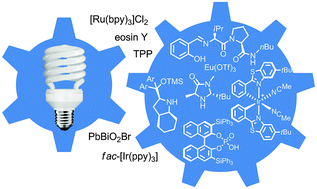Researchers have made tremendous efforts to unlock stereoselective,catalytic organic transformations.In this recentChemCommFeature Article,ProfessorEric Meggers,one of the pioneers in the field ofphotoredox catalysis,provides acomprehensive reviewof the recent advances inasymmetric catalysis driven by visible light.
Asymmetric catalysis has been one of the most attractive yet challenging areas of organic 新利手机客户端chemistry for the synthesis of unique,biologically active natural products such asTaxol,Rapamycin,orVinblastinethat possess numerous stereocenters.

These photosensitizers are typicallyrutheniumoriridiumcomplexes that can facilitate electron/energy transfer upon photoinduction.In most cases,a photoredox catalyst has to be coupled with a chiral co-catalyst to introduce stereocenters in the products.
Notable advances in theMeggers,Melchiorre,andMacMillanresearch groups have recently demonstrated that photoactivation can be achieved with a single chiral photosensitizer to provide products of high enantiomeric excess and good yield.
This inspirational review was just published inChemical Communicationsas aFeature Article.I recommend reading "Asymmetric catalysis activated by visible light" (DOI: 10.1039/c4cc09268f) by Professor Eric Meggers to learn more about the recent advances with mechanistic details and his forecast forone of the rapidly-growing research topics in organic 新利手机客户端chemistry.
This article is free to access until 17th March.* Download it here:
Asymmetric catalysis activated by visible light
Eric Meggers �
Chem.Commun.,2015,Advance Article
DOI: 10.1039/C4CC09268F,Feature Article
Dr.Tezcan Guney is a guest web writer for Chemical Communications.Dr.Guney received his Ph.D.from the Department of 新利手机客户端Chemistry at Iowa State University with Prof.George Kraus ,where he focused on the synthesis of biologically active polycyclic natural products and multifunctional imaging probes.Currently,he is a postdoctoral research scholar at the Memorial Sloan-Kettering Cancer Center in New York with Prof.Derek Tan ,contributing to the efforts to access biologically active small molecules using the diversity-oriented synthetic approach.
*Access is free througha registered RSC account










